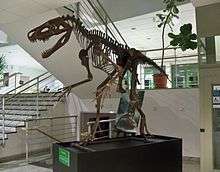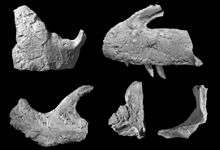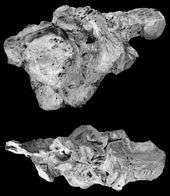Smok (archosaur)
| Smok Temporal range: Late Triassic, 205–200 Ma | |
|---|---|
 | |
| Reconstructed skeleton, University of Warsaw | |
| Scientific classification | |
| Kingdom: | Animalia |
| Phylum: | Chordata |
| Class: | Reptilia |
| Clade: | Archosauria |
| Genus: | †Smok Niedźwiedzki, Sulej & Dzik, 2012 |
| Species: | †S. wawelski |
| Binomial name | |
| Smok wawelski Niedźwiedzki, Sulej & Dzik, 2012 | |
Smok (meaning "dragon" in Polish) is an extinct genus of large carnivorous archosaur. It lived during the latest Triassic period (latest Norian to early Rhaetian stage, between 205–200 Ma). Its remains have been found in Lisowice, southern Poland. The type species is Smok wawelski (after the Wawel Dragon) and was named in 2012. It is larger than any other known predatory archosaur from the Late Triassic or Early Jurassic of central Europe. The relation of Smok to other archosaurs has not yet been thoroughly studied; it may be a rauisuchid, prestosuchid or ornithosuchid crurotarsan (part of the crocodile line of archosaurs) or a theropod dinosaur (part of the bird line of archosaurs).[1]
Description

At an estimated 5 to 6 metres (16 to 20 ft) in length, Smok was the largest carnivorous archosaur in central Europe at the time. It was larger than any other known theropod dinosaur or pseudosuchian living in central Europe during either the Late Triassic or Early Jurassic. The skull is 50 to 60 centimetres (20 to 24 in) long.[1]
Several features indicate that Smok is an archosaur, including serrated teeth, a contact between the jugal and quadratojugal bones at the back of the skull, a hole in front of the eye socket called the antorbital fenestra, maxillae bones in the upper jaw that connect along their palatal processes, and a rounded projection on the upper part of the femur bone.[1]
The braincase of Smok includes many derived (advanced) features. The most prominent of these is a funnel-shaped structure on the bottom of the braincase, formed by a very wide, rounded basisphenoid bone. A deep notch called the basisphenoid recess cuts into the back of this funnel. Above the funnel is a very thin area of the braincase that is formed by deep depressions on the basisphenoids.[1]

Smok has several features that are shared with both dinosaurs and crocodile-line archosaurs, making classification difficult. Similarities with theropods include a groove, or antitrochanter, on the ilium bone of the hip that is part of the acetabulum (a depression where the head of the femur attaches to the hip). Smok and theropods also have an anterior trochanter on the femur. Some large theropods share with Smok the deep depressions of the basisphenoids in the braincase. Similarities with rauisuchians include a triangular antorbital fenestra and a connection between the ectopterygoid and jugal bones of the skull that is split into two projections. The hip of Smok has a ridge on the lateral surface of the ilium above the acetabulum. This ridge is a defining characteristic of rauisuchians, forming a buttress over the femur and giving these animals a pillar-erect stance.[1]
Other features of Smok seem to exclude it from these groups of archosaurs. The premaxilla and maxilla of the upper jaw attach closely to each other, making a continuous row of evenly spaced teeth. Early theropods and orthithosuchids have a toothless gap between the premaxilla and the maxilla, distinguishing them from Smok. The upper jaw bones of rauisuchians are not closely connected, leaving a small opening between the premaxilla and maxilla that is not seen in Smok. Unlike many pseudosuchids and theropods, Smok does not have pneumatic areas, or air pockets, in the braincase. It also has several features that link it with primitive archosauromorphs, including the presence of a postfrontal bone on the skull and a closed acetabulum in the hip.[1]
Discovery and naming

Smok was found in a locality near Lisowice village that is latest Norian to early Rhaetian in age. This area was known to contain Triassic fossils since it was formally described in 2008. The first material of Smok, the jawbone and fragments of the skull, was discovered in 2007. It was first described in 2008 as a theropod dinosaur based on features in its braincase and frontal bone. The material was also thought to represent two individuals.[2] Similarities were noted between the braincase of the animal and that of allosaurs. When the discovery was first announced, it was called "the Dragon of Lisowice" and was purported to be the first member of a line of dinosaurs that led to Tyrannosaurus rex.[3] Bones from other parts of the body were found in 2009 and 2010. Five tracks made by a three-toed archosaur – presumably a theropod dinosaur – were found in rocks that were 1 metre (3.3 ft) above the layer where Smok was found. The footprints may belong to Smok, but the lack of foot bones in the skeleton make this association uncertain.[1]

Smok is known from the holotype ZPAL V.33/15, a partially complete braincase which is associated with a partially preserved skeleton, including cranial and postcranial bones from the referred materials ZPAL V.33/16-56, 97-102, 295-314, 434 and 507. All specimens were found in the same location (Lipie Śląskie clay-pit Formation) and probably represent a single individual. It was first named by Grzegorz Niedźwiedzki, Tomasz Sulej and Jerzy Dzik in 2011, after the mythological Polish dragon of the same name that lived in a cave near the excavation site. The cave was on Wawel Hill, the namesake of the type species S. wawelski.[1]
Paleoecology
Smok was the largest predator in its environment. Other large predatory archosaurs included the dinosaur Liliensternus and the rauisuchids Polonosuchus and Teratosaurus, but these animals were much smaller than Smok. It was one of the largest archosaurs in the world during the Late Triassic, and larger archosaurs did not appear until after the Early Jurassic. Smok lived alongside small carnivorous dinosauromorph and poposauroid archosaurs and large herbivorous dicynodonts.[1]
References
- 1 2 3 4 5 6 7 8 9 Grzegorz Niedźwiedzki, Tomasz Sulej and Jerzy Dzik (2012). "A large predatory archosaur from the Late Triassic of Poland" (PDF). Acta Palaeontologica Polonica. 57 (2): 251–256. doi:10.4202/app.2010.0045.
- ↑ Dzik, J.; Sulej, T.; Niedźwiedzki, G. (2008). "A dicynodont−theropod association in the latest Triassic of Poland" (PDF). Acta Palaeontologica Polonica. 53 (4): 733–738. doi:10.4202/app.2008.0415.
- ↑ Sulej, T.; Niedźwiedzki, G. (2009). "Dawn of the Dinosaurs: The discovery of large reptile fossils in Silesia" (PDF). Academia. 2 (22): 34–35.